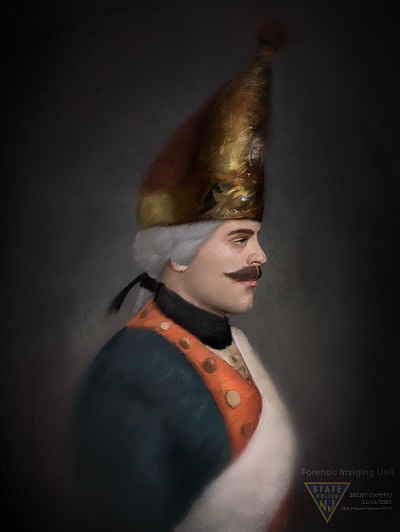
A young, healthy German soldier woke up in his Haddonfield barracks on Oct. 22, 1777, put on his Hessian uniform and marched with 2,000 other mercenaries some 10 miles to attack Fort Mercer.
By sunset he lay dead – buried in a mass grave at the Red Bank Battlefield.
Using the skull from the remains of one of 15 Hessians discovered in 2022, state police sketch artist Moises Martinez was able to create an amazing depiction of the soldier, one of 82 Hessians killed during the battle at Fort Mercer.
“When I first saw the facial reconstruction it took my breath away,” recalled Red Bank Battlefield director Jen Janofsky, a professor of public history at Rowan University in Glassboro. “It was definitely an emotional moment to see this individual as a human being really brought home the mission of this project.
“As a historian, I am used to working with traditional sources like papers, maps, letters – that kind of thing,” she added. “The battle has always seemed a little abstract to me. It’s one thing to talk about ‘over 300 dead or injured Hessians.’ It’s a completely different experience to recover those remains and to hold those remains. It has really brought the reality of a Revolutionary War battlefield home.
“They’re not abstract numbers anymore, they’re human beings.”
Janofsky and Rowan archaeologist Wade P. Catts led a public dig in 2022. Over four days, some 100 volunteers worked screens and processed artifacts from the quarter-acre trench area deeded to the battlefield in 2021 by the family who owned the grounds. On the last day, the remains of 15 Hessian soldiers were found.
“They were unceremoniously dumped in a mass grave,” noted Janofsky, who hopes at least one soldier will be identified. It would be absolutely incredible to identify two. In the event we identify an individual, we will certainly work to identify a descendant community in Germany, and of course we would welcome them to visit Red Bank Battlefield Park.”
Helping with the identification effort are organizations, archaeologists and forensic experts from across the nation, including state police; Rowan University students; contacts in Germany; Astrea Forensics in California; Utica University and the University of Georgia; and Dartmouth College, among others.
“The best public history projects are collaborative in nature,” Janofsky explained. “This project is a true team effort. It has grown from historians and archaeologists to forensic anthropologists and bio-archaeologists and Rowan University students.
“As a professor, student involvement in the project has been an amazing experience,” she added. “The opportunity for students to work with top experts in the field is deeply impactful for their education. Everyone involved is committed to exhausting all resources to identify these individuals.”
Another aspect of the project is to educate people about what happened some 247 years ago. This month, there were two public guided walking tours of the Hessian burial site, which was offered Saturday, Aug. 10 and next, Saturday, Aug. 24.
“We are sharing the remarkable story of their (soldiers’) discovery along with powerful images from the project,” Janofsky said. “We tend to have a sanitized view of the Revolution, but these were horribly violent battles that saw tremendous pain and suffering.
“We want to complicate people’s understanding of the ‘enemy,'” she continued. “They were human beings, they had families. They suffered and died on our battlefield. I want people to enjoy the park, but I also want people to appreciate the pain that landscape holds.”
Some 2,000 Hessian troops marched 10 miles on Oct. 22, 1777, from Haddonfield to Fort Mercer, located along the Delaware River in current day National Park. German mercenaries hired by the British government hoped to overrun the fort, making it easier for ships to get up the river and resupply the enemy army based in Philadelphia.
The 400 soldiers defending the fort were the war-hardened Continental Army troops of the Rhode Island First and Second regiments, and they got a big break when patriot Jonas Cattell ran from Haddonfield through the backwoods ahead of the Hessian troops to raise the alarm: “The Hessians are Coming.”
Col. Christopher Greene – a distant cousin of Revolutionary War hero General Nathanael Greene – quickly ordered the patriots, many of whom were African Americans and Native Americans, to turn around the cannons pointing at the river and face the oncoming attack by land.
After the hour-long battle, 82 Hessian soldiers lay dead in the trench surrounding the fort after an unsuccessful attempt to scale its walls. Another 228 were wounded in the Battle of Red Bank and 60 were captured. The heavily outnumbered Continental Army troops reported 14 killed and 23 wounded.
One of those Hessian soldiers now has a human face in the composite sketch. A cone-shaped headdress perches on his head. His hair peeks out from underneath, falling to the nape of his neck. His gaze is transfixed, seemingly focused on duty.
His posture is perfect, his mustache thick. Even in full military regalia, he looks like a young man.









